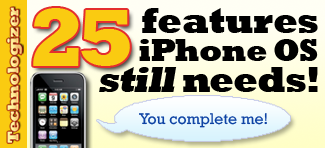 As promised, Apple has released iPhone OS 3.0. I’ve been using the gold master version for a week, and it’s been a joy so far.
As promised, Apple has released iPhone OS 3.0. I’ve been using the gold master version for a week, and it’s been a joy so far.
Apple’s approach to the the iPhone’s development still makes me think of Benjamin Button: The OS was dazzling from the start, but only Apple intentionally put off implementing some of the mundane, basic stuff that you would have assumed every phone OS would have. With 3.0, it’s mostly there. (Which hasn’t stopped me from starting to compile a wish list of new features.)
iPhone 2.0 was about one sea change of a new feature: third-party apps. 3.0, by contrast, sports no one signature improvement. It really is about improvement everywhere. (Here’s an excellent point-by-point account of the hundred new features.)
 For me, the single most meaningful new feature so far, by far, is search–especially within e-mail, where it’s beautifully done and makes the e-mail app far more useful. (I had stopped using the iPhone Mail in favor of Gmail; now I’ve switched back.) The far more widespread support for landscape-mode use of applications is a close second. Apple also says that Safari is faster, and while I haven’t done any benchmarks, the browser does indeed feel much snappier.
For me, the single most meaningful new feature so far, by far, is search–especially within e-mail, where it’s beautifully done and makes the e-mail app far more useful. (I had stopped using the iPhone Mail in favor of Gmail; now I’ve switched back.) The far more widespread support for landscape-mode use of applications is a close second. Apple also says that Safari is faster, and while I haven’t done any benchmarks, the browser does indeed feel much snappier.
 It’s also fun to burrow around the OS and encounter minor-but-welcome tweaks all over the place, like the way the camera app now shows a thumbnail link to the last photo you snapped. And if AT&T ever permits tethering–and offers a network that doesn’t lapse into EDGE at the worst moments–I’ll be thrilled.
It’s also fun to burrow around the OS and encounter minor-but-welcome tweaks all over the place, like the way the camera app now shows a thumbnail link to the last photo you snapped. And if AT&T ever permits tethering–and offers a network that doesn’t lapse into EDGE at the worst moments–I’ll be thrilled.
 Oh, and in case you hadn’t heard, iPhones now let you cut, copy, and paste. I wasn’t irate when the OS didn’t have this feature, and haven’t needed it so far. But it’s there, and it works well.
Oh, and in case you hadn’t heard, iPhones now let you cut, copy, and paste. I wasn’t irate when the OS didn’t have this feature, and haven’t needed it so far. But it’s there, and it works well.
Much of what’s interesting about OS 3.0 will only reveal itself as new third-party applications come out: notifications, in-store purchasing, peer-to-peer connectivity, http video streaming, better GPS and map support, peripheral connectivity through the dock connector, and more. They’ll only live up to their potential if they’re widely embraced by developers. But everything we know about the iPhone as an app platform suggests that there’s every reason to be optimistic.
When Apple released iPhone 2.0 last July, there was widespread griping that it was buggy and unstable. Two months late, Apple polished the OS up with the much smoother OS 2.1. I can only speak about m y own personal experience with iPhone OS 3.0 to date, and sample sizes of one aren’t statistically significant. But it hasn’t crashed on me, and has actually made my iPhone more reliable: Until now, my phone’s Internet connection has had a nasty habit of stalling until I did a reboot, and–as far as I can tell–OS 3.0 has eliminated this major headache.
On Friday, some owners of iPhone 3Gs will spend hundreds of dollars to upgrade to the not-radically-different iPhone 3G S–in some cases grumbling as they do so. iPhone 3.0 brings most of what’s cool about the 3G S to any iPhone–for free. (For iPod Touch owners, it costs $10, and is merely a steal.) To riff on an old Apple OS X upgrade slogan, it’s like a new iPhone for your iPhone.
Once you’ve checked it out, let us know what you think.
 Here’s one of those breaking stories that’s stunning at first–until you think about it, whereupon it feels like it was always inevitable. Google announced tonight that it’s working on an operating system for PCs, turning a hypothetical scenario that’s been around for years into reality. Almost by definition, it’s the most direct attack possible on the Microsoft hegemony, since it puts Google into competition with Windows itself.
Here’s one of those breaking stories that’s stunning at first–until you think about it, whereupon it feels like it was always inevitable. Google announced tonight that it’s working on an operating system for PCs, turning a hypothetical scenario that’s been around for years into reality. Almost by definition, it’s the most direct attack possible on the Microsoft hegemony, since it puts Google into competition with Windows itself.
 Writing about Firefox 3.5 got me wondering: What’s the breakdown of browser usage on Technologizer right now? So I looked it up, courtesy of Google Analytics.
Writing about Firefox 3.5 got me wondering: What’s the breakdown of browser usage on Technologizer right now? So I looked it up, courtesy of Google Analytics. Microsoft has dropped one of the lat remaining veils relating to Windows 7 by
Microsoft has dropped one of the lat remaining veils relating to Windows 7 by  As promised, Apple has
As promised, Apple has  For me, the single most meaningful new feature so far, by far, is search–especially within e-mail, where it’s beautifully done and makes the e-mail app far more useful. (I had stopped using the iPhone Mail in favor of Gmail; now I’ve switched back.) The far more widespread support for landscape-mode use of applications is a close second. Apple also says that Safari is faster, and while I haven’t done any benchmarks, the browser does indeed feel much snappier.
For me, the single most meaningful new feature so far, by far, is search–especially within e-mail, where it’s beautifully done and makes the e-mail app far more useful. (I had stopped using the iPhone Mail in favor of Gmail; now I’ve switched back.) The far more widespread support for landscape-mode use of applications is a close second. Apple also says that Safari is faster, and while I haven’t done any benchmarks, the browser does indeed feel much snappier. It’s also fun to burrow around the OS and encounter minor-but-welcome tweaks all over the place, like the way the camera app now shows a thumbnail link to the last photo you snapped. And if AT&T ever permits tethering–and offers a network that doesn’t lapse into EDGE at the worst moments–I’ll be thrilled.
It’s also fun to burrow around the OS and encounter minor-but-welcome tweaks all over the place, like the way the camera app now shows a thumbnail link to the last photo you snapped. And if AT&T ever permits tethering–and offers a network that doesn’t lapse into EDGE at the worst moments–I’ll be thrilled. Oh, and in case you hadn’t heard, iPhones now let you cut, copy, and paste. I wasn’t irate when the OS didn’t have this feature, and haven’t needed it so far. But it’s there, and it works well.
Oh, and in case you hadn’t heard, iPhones now let you cut, copy, and paste. I wasn’t irate when the OS didn’t have this feature, and haven’t needed it so far. But it’s there, and it works well.
 Is it possible to out-iPhone the iPhone? Again and again, we’ve seen other manufacturers come up with phones that try so very hard to look and work like Apple’s blockbuster, such as
Is it possible to out-iPhone the iPhone? Again and again, we’ve seen other manufacturers come up with phones that try so very hard to look and work like Apple’s blockbuster, such as